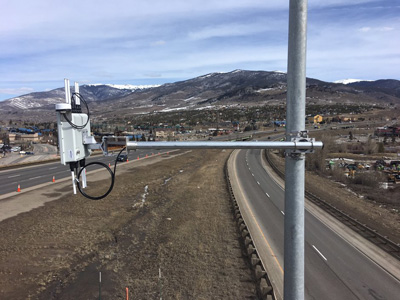Colorado is moving forward with the development of a “digital highway,” as the state sets the foundation for the rollout of “connected” vehicles that can share data with one another and transportation officials.
The Colorado Department of Transportation, in partnership with Panasonic Corp. of North America, will begin installing a network of roughly 100 roadside units along I-70 between Golden and Vail, a stretch of about 90 miles, and expects to have the digital corridor complete and operational by the end of the year. The roadside devices will be able to communicate with the state’s Traffic Management Center, as well as connected vehicles.
In the next three to five years, a number of automakers, including General Motors, Ford, Toyota and Volkswagen, have announced plans to include connected vehicle technology on some or all of their cars.
The system will enable a “vehicle-to-everything”—known as V2X—environment where cars can share billions of data points an hour related to speed and other operations, which are fed into the system to generate alerts and other information.
With so much traffic data flowing into the state’s DoT, officials can analyze and manage traffic in ways that can only be dreamed of using current technology. The idea is to create a driving environment that operates more safely and efficiently.
“That is why, honestly, we’re making the investment that we are. We truly believe that this technology, and where this is going, is going to save lives,” said Amy Ford, chief of advanced mobility at the Colorado Department of Transportation.
“And it will also, in reducing crashes, etc., improve the capacity of our roadways,” she added.
The project comes on the heels of a smaller-scale pilot where Panasonic installed and tested five V2X roadside units, along with six of the onboard vehicle units, creating a connected system officials have loosely called an “Internet of roads.”
The 90-mile I-70 corridor will mark the state’s first full-scale deployment of the system, said Ford, adding that there are plans to use the technology all around the state. The I-70 route was picked for several reasons: variable terrain in an area that often sees rain, snow and ice.
“It’s got sort of everything. If you can make all of this work here, it works everywhere,” said Ford.
Installing the roadside units will cost about $2 to $3 million, and the partnership with Panasonic—to develop the “data ecosystem”—is expected to cost about $10 million for the next five years.
“So it’s about a $70 million program right now to essentially build the brain behind the scenes to allow for, frankly, the world’s first commercial-level deployment of this kind of connected vehicle eco-system,” said Ford.
The Colorado project could be a leader in the emerging field of connected vehicles and highways. However, other cities and states are also beginning to experiment in this area.
Columbus, Ohio, recently announced a project to install up to 1,800 on-board devices in public and private cars, as well as upgrade some 113 signalized intersections in its effort to create a “connected Vehicle Environment,” in a plan to test the technology’s efficacy at improving traffic safety.
Tampa Bay, Fla. is in the midst of a connected vehicle pilot, which involves some 1,600 private vehicle drivers who use the Lee Roy Selmon Expressway. That project is set to run through the end of 2019.
“Colorado is a global leader in creating an environment where V2X technology can thrive,” said Jarrett Wendt, executive vice president at Panasonic Corp. of North America, in a statement. “Their openness to deploying new technologies in a real-world setting is an exciting and innovative approach, allowing them to attract top industry talent and private investment to the state. And most importantly, deliver on their mission to improve the safety of Colorado roadways.”

